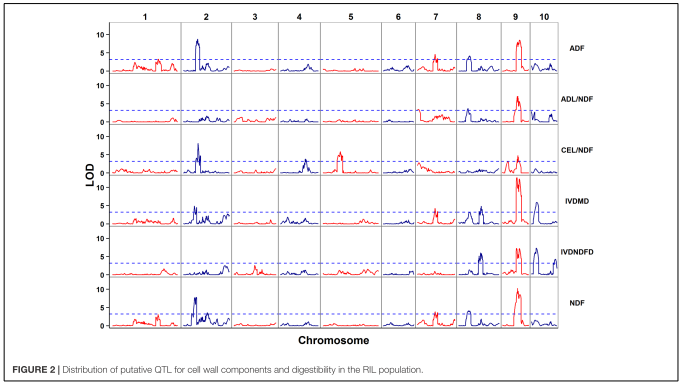Genetic and Quantitative Trait Locus Analysis of Cell Wall Components and Forage Digestibility in the Zheng58 × HD568 Maize RIL Population at Anthesis Stage
作 者:Kun Li, Hongwu Wang, Xiaojiao Hu, Feiqian Ma, Yujin Wu, Qi Wang, Zhifang Liu, and Changling Huang
影响因子: 4.298
刊物名称: Frontiers in plant science
出版年份: 2017
卷: 8 期:24 August 页码: 1472
doi:10.3389/fpls.2017.01472
文章摘要 :
The plant cell wall plays vital roles in various aspects of the plant life cycle. It provides a basic structure for cells and gives mechanical rigidity to the whole plant. Some complex cell wall components are involved in signal transduction during pathogenic infection and pest infestations. Moreover, the lignification level of cell walls strongly influences the digestibility of forage plants. To determine the genetic bases of cell wall components and digestibility, quantitative trait locus (QTL) analyses for six related traits were performed using a recombinant inbred line (RIL) population from a cross between Zheng58 and HD568. Eight QTL for in vitro neutral detergent fiber (NDF) digestibility were observed, out of which only two increasing alleles came from HD568. Three QTL out of ten with alleles increasing in vitro dry matter digestibility also originated from HD568. Five–ten QTL were detected for lignin, cellulose content, acid detergent fiber, and NDF content. Among these results, 29.8% (14/47) of QTL explained >10% of the phenotypic variation in the RIL population, whereas 70.2% (33/47) explained ≤10%. These results revealed that in maize stalks, a few large-effect QTL and a number of minor-effect QTL contributed to most of the genetic components involved in cell wall biosynthesis and digestibility.
下载链接:http://www.ncbi.nlm.nih.gov/pmc/articles/PMC5573715/





